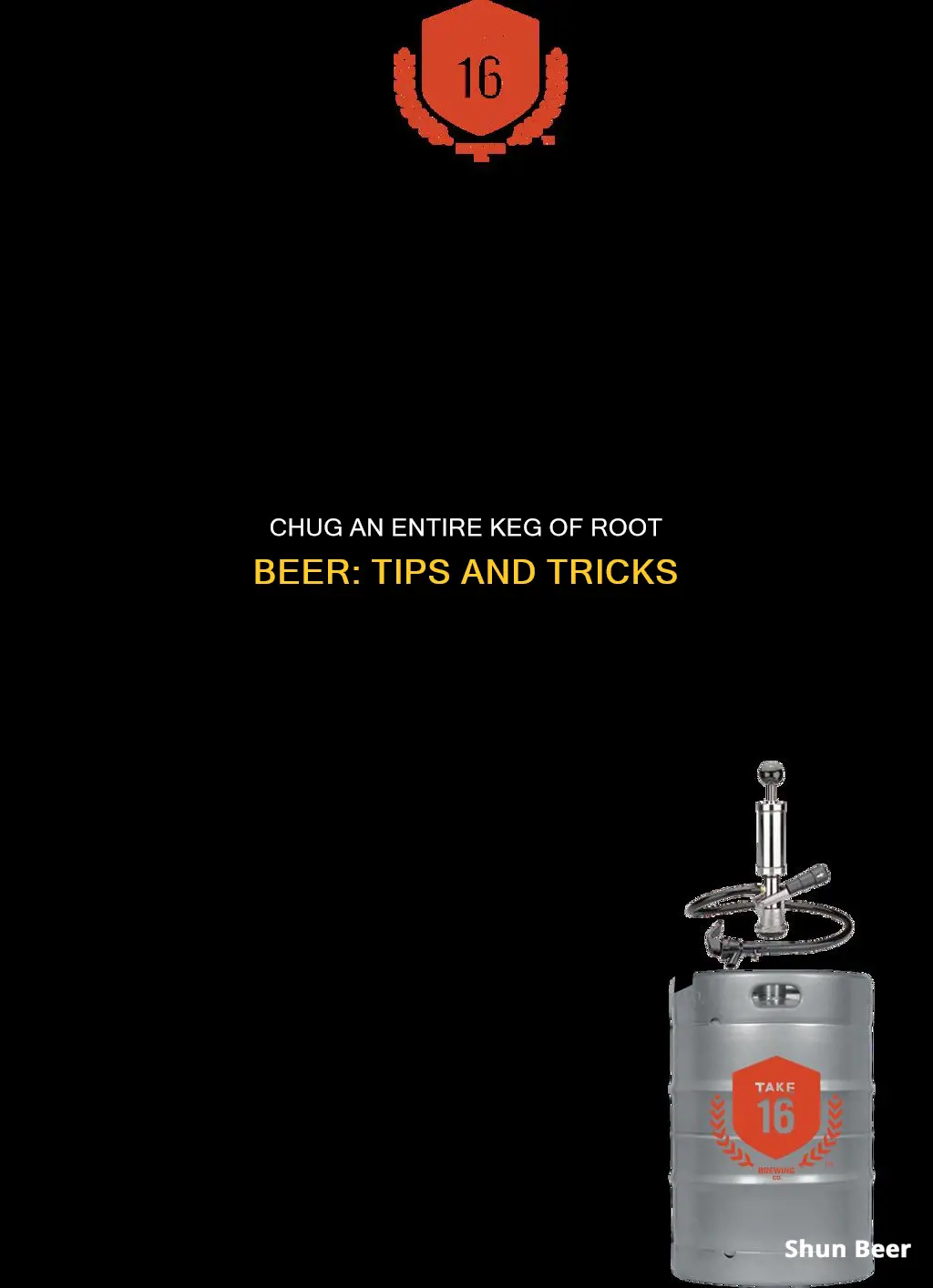
Root beer is a distinctly American drink with a sweet, herbal flavour that has been made since the colonial era. It is possible to make it at home and even put it in a keg. The process involves making an herbal decoction by simmering herbs in water, then sweetening the brew and adding a starter culture so that it ferments. Finally, the root beer is bottled and left to culture, creating a natural fizz. The carbonation process can be done in a few different ways, but one way is to use a keg setup. This involves pouring the root beer syrup through a funnel into the keg, filling it with cool tap water, sealing the keg, and then hooking it up to carbon dioxide (CO2) to start the carbonation process.
What You'll Learn
- Carbonation methods: force carbonation or natural carbonation
- Choosing a sweetener: sugar, honey, maple syrup, maple sugar, or coconut sugar
- Signature flavours: vanilla, cinnamon, cloves, allspice, wintergreen, sweet birch, anise, licorice root, or burdock
- The right equipment: keg, faucet, funnel, pot, CO2 tank, regulator, gas assembly, and kegerator
- Fermentation: the role of temperature, the importance of using a starter culture, and the benefits of probiotics

Carbonation methods: force carbonation or natural carbonation
Carbonation is the process of adding carbon dioxide gas to a liquid. There are two main methods of carbonation: force carbonation and natural carbonation.
Force Carbonation
Force carbonation involves pumping carbon dioxide into a closed tank or container containing the liquid. This is done to prevent gas from escaping or air from entering. A regulator is necessary to ensure the correct pressure of CO2 is applied to achieve the desired level of carbonation. Once the desired pressure is reached, the tank is sealed and allowed to sit for several days to fully carbonate the beverage. This method is faster and provides more control over the carbonation level compared to natural carbonation. It involves the use of specific equipment, such as a CO2 tank, regulator, and keg, as well as careful monitoring of pressures and temperatures.
Natural Carbonation
Natural carbonation, on the other hand, uses priming sugar and yeast. In the presence of yeast, the sugar is consumed and converted mainly into CO2, along with a small amount of additional alcohol. This technique usually takes several weeks and requires careful control of the amount of priming sugar to avoid excessive carbonation. Natural carbonation can be achieved through bottle conditioning, where the priming solution is added to the beer before bottling, or directly in a keg. This method is favoured by some beer enthusiasts as it produces a more complex and enjoyable carbonation profile, allowing for the development of subtle flavours and aromas.
Beer and Drug Tests: What You Need to Know
You may want to see also

Choosing a sweetener: sugar, honey, maple syrup, maple sugar, or coconut sugar
When making root beer, you can use a variety of sweeteners, including sugar, honey, maple syrup, maple sugar, or coconut sugar. Each sweetener has its own unique flavour and nutritional profile, so choosing the right one for your root beer is important.
Sugar
Sugar, also known as sucrose, is a type of carbohydrate that is derived from cane or beets. It is made up of a combination of glucose and fructose, which are simple sugars that are easily absorbed and metabolized by the body. Sugar is highly processed and has no vitamins or minerals, so it may not be the best choice for those looking for a more natural sweetener.
Honey
Honey is a natural sweetener that is primarily made up of fructose and glucose, with some sucrose. It contains trace amounts of vitamin C and B vitamins, but you would have to consume a large amount of honey to receive any significant nutritional benefit. Honey has a floral taste and is a good choice for sweetening tea or other beverages.
Maple Syrup
Maple syrup is a natural sweetener made by boiling the sap of maple trees. It has a woody and sweet flavour with notes of caramel, vanilla, cinnamon, and hazelnut. Maple syrup also has a lower glycemic index than cane sugar, which means it won't cause your blood sugar to spike as quickly. In addition, maple syrup contains antioxidants and minerals such as calcium, iron, magnesium, and potassium.
Maple Sugar
Maple sugar is made from the sap of maple trees, just like maple syrup. The sap is boiled down until it forms a crystalline structure, resulting in a sweetener that looks and tastes similar to brown sugar. Maple sugar can be used as a 1:1 replacement for sugar in recipes and has the same nutritional benefits as maple syrup.
Coconut Sugar
Coconut sugar is made from the sap of coconut palm flowers and has a taste similar to maple syrup or brown sugar. It has a lower glycemic index than maple syrup, which means it will cause your blood sugar to rise more slowly. Coconut sugar also contains trace amounts of vitamins and minerals, including vitamin C, potassium, and magnesium.
When choosing a sweetener for your root beer, consider the flavour profile you want to achieve, as well as the nutritional benefits of each option. Remember that all of these sweeteners are forms of sugar and should be consumed in moderation as part of a balanced diet.
Beer and Fishing: What's the Legal Catch?
You may want to see also

Signature flavours: vanilla, cinnamon, cloves, allspice, wintergreen, sweet birch, anise, licorice root, or burdock
Vanilla, cinnamon, cloves, allspice, wintergreen, sweet birch, anise, licorice root, and burdock are all signature flavours of root beer.
Vanilla is a common ingredient in root beer, adding a sweet and rich flavour. Cinnamon is also frequently used, providing a warm and slightly spicy taste. Cloves bring a strong, pungent aroma with a hint of sweetness, while allspice lends a similar spicy kick. Wintergreen is another key component, contributing a sweet, minty taste. Sweet birch, with its subtle sweetness and depth of flavour, is often used in combination with licorice root, which has a distinct licorice taste. Anise, with its sweet and spicy notes, is another signature spice, and burdock root helps to give root beer its strong, rooty flavour.
These signature flavours can be combined in various ways, resulting in the unique taste profiles of different root beer brands and recipes.
Beer and Apple: A Delicious Pairing?
You may want to see also

The right equipment: keg, faucet, funnel, pot, CO2 tank, regulator, gas assembly, and kegerator
To drink an entire keg of root beer, you'll need the right equipment. Here's a list of the essential items you'll need:
The Keg
The first thing you'll need is a keg! Look for a stainless steel keg, such as the Cornelius or "corny" keg, which is commonly used in the beverage industry and comes in various sizes. You'll want to make sure it has two connections, called quick-disconnects: one for the hose that feeds CO2 into the keg and another for the beverage line that dispenses your root beer.
The Faucet
Next, you'll need a faucet, also known as a tap, to dispense your root beer. You can go with a simple and inexpensive option like a picnic tap, or you can opt for a nicer tap handle by building a kegerator or jockey box.
The Funnel
A funnel will come in handy when it's time to fill your keg with root beer. Make sure to get one that's the right size and fits securely onto your keg to avoid any messy spills.
The Pot
You'll need a large pot to mix your root beer syrup. A 2-gallon pot or larger should do the trick, giving you enough room to mix your ingredients and create a delicious root beer syrup.
The CO2 Tank
Carbonation is key to making your root beer fizzy and refreshing. For this, you'll need a CO2 tank, which you can rent or buy. This tank will provide the carbon dioxide gas to infuse your root beer with those delightful bubbles.
The Regulator
To control the release of CO2 from the tank, you'll need a regulator. This device has two dials: one to measure the amount of gas in the tank and the other to gauge the pressure coming out of the tank and into the keg. It allows you to adjust the carbonation level to your desired fizziness.
The Gas Assembly
The gas assembly is essential for connecting the CO2 tank to the keg and facilitating the flow of carbon dioxide into your root beer. It includes the hoses and connectors needed for a secure and proper setup.
The Kegerator
Last but not least, you'll need a kegerator or a refrigerator large enough to hold your keg. This will keep your root beer nice and cool, ready to be dispensed and enjoyed. If you don't have a kegerator, any refrigerator that can accommodate a 5-gallon keg and allow you to connect the necessary hoses will do the trick.
With these pieces of equipment, you'll be well on your way to enjoying that entire keg of root beer. Remember to follow the proper steps for mixing, carbonating, and dispensing your root beer for the best results.
Hipsters and Craft Beer: A Cultural Obsession?
You may want to see also

Fermentation: the role of temperature, the importance of using a starter culture, and the benefits of probiotics
Fermentation is a crucial process in brewing, where yeast converts the glucose in wort into ethyl alcohol and carbon dioxide gas, giving beer its carbonation and alcohol content. The ideal beer fermentation temperature is between 68 and 72° F, with lagers requiring lower temperatures of 45 to 55° F. Maintaining the right temperature is critical as fermenting above these ranges can lead to the production of fruity-flavored esters and harsh-flavored fusel alcohols. Additionally, if the temperature gets too high, fermentation may stop.
To ensure proper temperature control during fermentation, brewers can employ various strategies. One approach is to use the cooling power of evaporation by wrapping the carboy in a damp towel and placing it in a basin with water, allowing the towel to wick water and keep the brew cool through evaporation. Another simple method is to place the carboy directly in front of an air conditioning vent to receive the initial cool blast of air. Alternatively, the carboy can be placed in a basin with water and ice packs or frozen water bottles, which need to be replaced twice a day.
For more precise temperature control, portable chillers are an effective option. These chillers only require a power connection and can help brewers maintain the desired temperature with ease, ensuring a high-quality brew.
The role of temperature also extends to the benefits of probiotics in root beer. Probiotics are live microorganisms that offer health benefits when consumed, and they are often added to root beer to enhance its nutritional profile. While the specific strains of probiotics used in root beer can vary, they typically include species from the genera Lactobacillus, Bifidobacterium, and Saccharomyces. These probiotics thrive in the slightly acidic environment of root beer, which typically has a pH range of 2.5 to 4.0. The acidic conditions created by the fermentation process contribute to inhibiting the growth of undesirable bacteria, creating an optimal environment for the survival and activity of beneficial probiotic strains.
The importance of using a starter culture in root beer fermentation cannot be overstated. Starter cultures are preparations with a large number of cells, either consisting of a single type of microorganism or a mixture of two or more. They are added to root beer to initiate and direct the fermentation process, ensuring a consistent and desirable outcome. The microorganisms selected for starter cultures are often isolated from the native microbiota of traditional products, as they are well-adapted to the environmental conditions of food processing.
The use of starter cultures in root beer offers several advantages. Firstly, they help homogenize the production process, reducing variability and avoiding potential defects. Secondly, starter cultures improve the safety of the final product by producing compounds such as lactic acid, acetic acid, and bacteriocins, which inhibit the growth of pathogenic and spoilage microorganisms. This results in an extended shelf life for the root beer. Additionally, starter cultures can play a role in reducing the formation of undesirable compounds, such as biogenic amines and polycyclic aromatic hydrocarbons, further enhancing the safety and quality of the beverage.
A Fun Pair: Watermelon, Beer, and Their Unexpected Harmony
You may want to see also
Frequently asked questions
If your root beer is still flat, revisit your carbonation methodology. To make your drink fizz, you can increase the carbonation level by decreasing the temperature as close to freezing as possible without freezing the liquid.
You will need a range of aromatic herbs, sugar, and a starter culture like ginger bug or kombucha.
It takes a few days to make root beer.
Traditional root beer is made by fermenting an herbal decoction of sassafras bark, sarsaparilla root, and other herbs with sugar and yeast to make a naturally bubbly, probiotic soft drink. Modern root beer is made with artificial flavours and carbonated.
You will need a Corney Keg, Keg Faucet, Funnel, 2-gallon pot or larger, CO2 tank, Regulator, Gas Assembly, and a Kegerator (or any refrigerator big enough to hold a 5-gallon keg).







